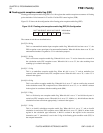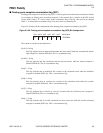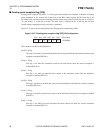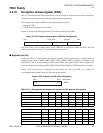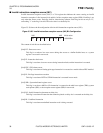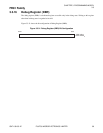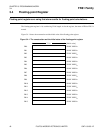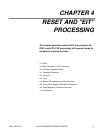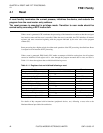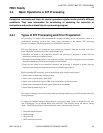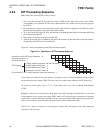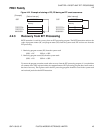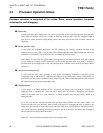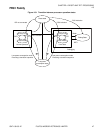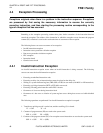
FR81 Family
42 FUJITSU MICROELECTRONICS LIMITED CM71-00105-1E
CHAPTER 4 RESET AND "EIT" PROCESSING
4.1
4.1 Reset
A reset forcibly terminates the current process, initializes the device, and restarts the
program from the reset vector entry address.
The reset process is executed in privilege mode. Transition to user mode should be
carried out by executing a RETI instruction.
When a reset is generated, CPU terminates the processing of the instruction execution at that time and goes
into inactive status until the reset is cancelled. When the reset is cancelled, the CPU initializes all internal
registers and starts execution beginning with the program indicated by the new value of the program
counter (PC).
Reset processing has a higher priority level than each operation of the EIT processing described later. Reset
is accepted even in between an EIT processing.
When a reset is generated, FR81 family CPU makes an attempt to initialize each register, but all registers
cannot be initialized. Each register sets a value through the program executed after a reset, and uses it.
Table 4.1-1 shows the registers that are initialized following a reset.
Table 4.1-1 Registers that are initialized following a reset
For details of My computer built-in functions (peripheral devices, etc.) following a reset, refer to the
Hardware Manual provided with each device.
Register Initial Value Remarks
Program counter (PC)
Word data at location 000F FFFC
H
Reset vector
Interrupt level mask register (ILM)
15(01111
B
)
Step trace trap flag (T) “0” Trace OFF
Interrupt enable flag (I) “0” Interrupt disabled
Stack flag (S) “0” Use SSP
Table base register (TBR)
000F FC00
H
System stack pointer (SSP)
0000 0000
H
Debug state flag (DBG)
“0”
No debug state
User mode flag (UM)
“0”
Privilege mode
Exception status register (ESR)
0000 0000
H
General-purpose register R15 SSP As per stack flag (S)



